COIT20248 - Information System Analysis & Design: UNICEF Child Care
VerifiedAdded on 2023/06/14
|14
|2886
|219
Report
AI Summary
This report presents a comprehensive analysis and design of an information system for UNICEF Child Care, focusing on the implementation of an ERP system to manage inventory, facilitate online payments, and improve communication between staff and parents. The report details the system requirements, including both functional and non-functional aspects, and provides a cost-benefit analysis to justify the investment in the new system. A project schedule, including a work breakdown structure, outlines the timeline for implementation. The report also discusses system information requirement investigation techniques and reflects on the potential benefits of the ERP system for UNICEF Child Care, highlighting improvements in operational efficiency, ethical practices, and customer satisfaction. Desklib offers a wealth of similar solved assignments and past papers for students seeking further assistance.
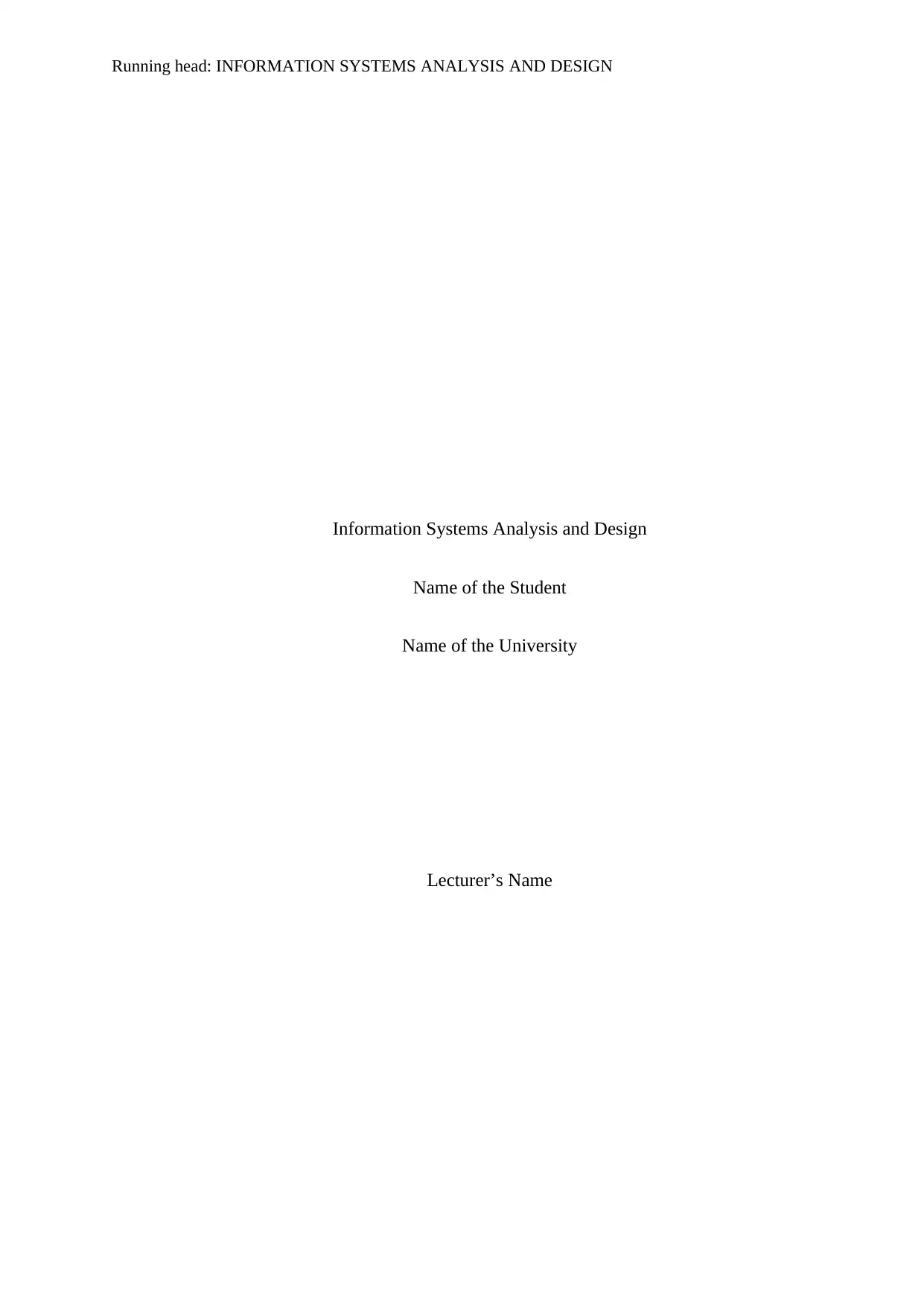
Running head: INFORMATION SYSTEMS ANALYSIS AND DESIGN
Information Systems Analysis and Design
Name of the Student
Name of the University
Lecturer’s Name
Information Systems Analysis and Design
Name of the Student
Name of the University
Lecturer’s Name
Paraphrase This Document
Need a fresh take? Get an instant paraphrase of this document with our AI Paraphraser

1INFORMATION SYSTEMS ANALYSIS AND DESIGN
Table of Contents
1. Introduction............................................................................................................................2
2. The Approach to Systems Development................................................................................2
3. Systems Requirements...........................................................................................................3
4. Project Cost /Benefit Analysis...............................................................................................5
5. Project Schedule.....................................................................................................................8
Project Plan............................................................................................................................8
Work Breakdown Structure....................................................................................................9
6. System Information Requirement Investigation Techniques...............................................10
7. Reflections and Conclusions................................................................................................11
8. References............................................................................................................................12
Table of Contents
1. Introduction............................................................................................................................2
2. The Approach to Systems Development................................................................................2
3. Systems Requirements...........................................................................................................3
4. Project Cost /Benefit Analysis...............................................................................................5
5. Project Schedule.....................................................................................................................8
Project Plan............................................................................................................................8
Work Breakdown Structure....................................................................................................9
6. System Information Requirement Investigation Techniques...............................................10
7. Reflections and Conclusions................................................................................................11
8. References............................................................................................................................12
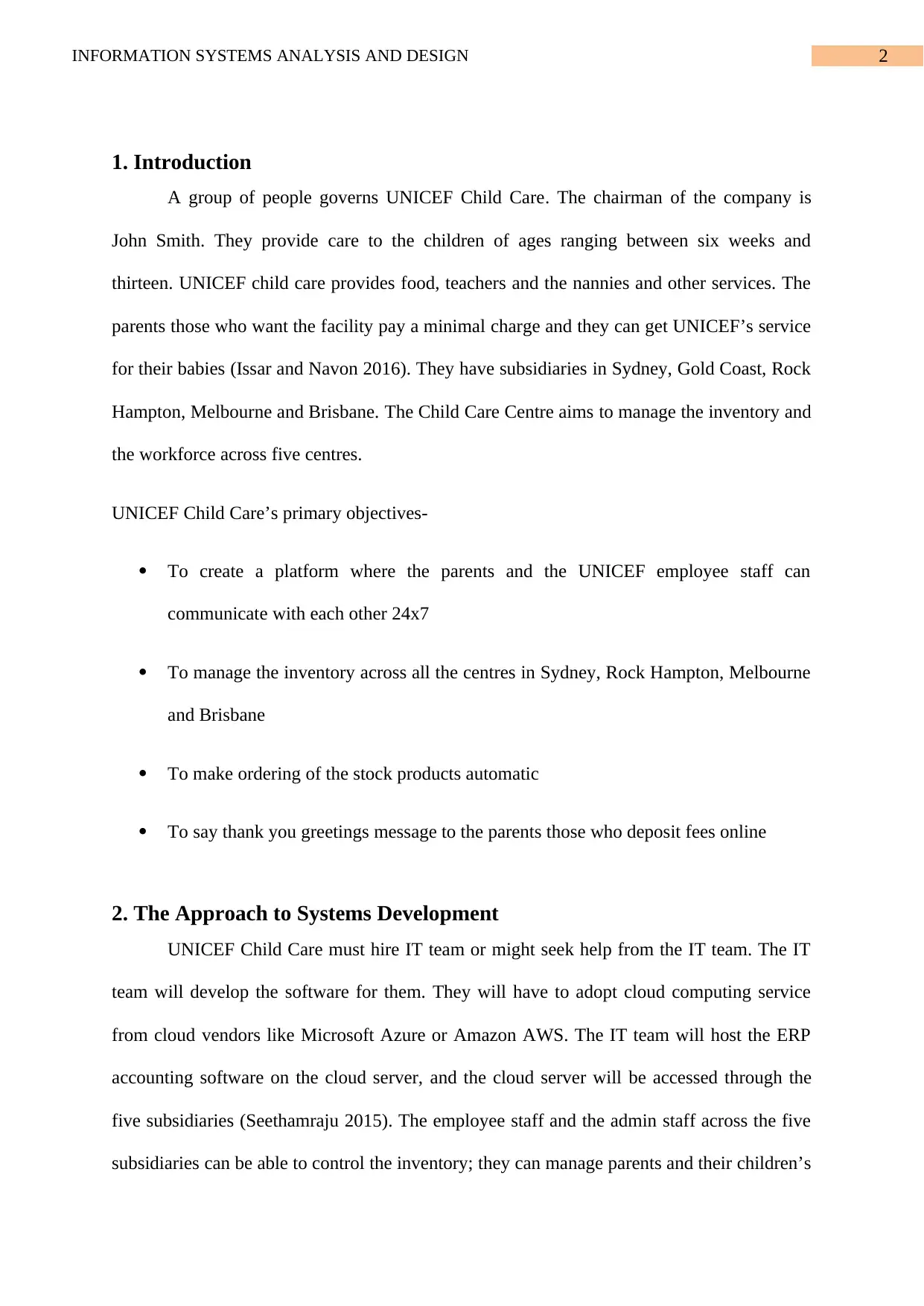
2INFORMATION SYSTEMS ANALYSIS AND DESIGN
1. Introduction
A group of people governs UNICEF Child Care. The chairman of the company is
John Smith. They provide care to the children of ages ranging between six weeks and
thirteen. UNICEF child care provides food, teachers and the nannies and other services. The
parents those who want the facility pay a minimal charge and they can get UNICEF’s service
for their babies (Issar and Navon 2016). They have subsidiaries in Sydney, Gold Coast, Rock
Hampton, Melbourne and Brisbane. The Child Care Centre aims to manage the inventory and
the workforce across five centres.
UNICEF Child Care’s primary objectives-
To create a platform where the parents and the UNICEF employee staff can
communicate with each other 24x7
To manage the inventory across all the centres in Sydney, Rock Hampton, Melbourne
and Brisbane
To make ordering of the stock products automatic
To say thank you greetings message to the parents those who deposit fees online
2. The Approach to Systems Development
UNICEF Child Care must hire IT team or might seek help from the IT team. The IT
team will develop the software for them. They will have to adopt cloud computing service
from cloud vendors like Microsoft Azure or Amazon AWS. The IT team will host the ERP
accounting software on the cloud server, and the cloud server will be accessed through the
five subsidiaries (Seethamraju 2015). The employee staff and the admin staff across the five
subsidiaries can be able to control the inventory; they can manage parents and their children’s
1. Introduction
A group of people governs UNICEF Child Care. The chairman of the company is
John Smith. They provide care to the children of ages ranging between six weeks and
thirteen. UNICEF child care provides food, teachers and the nannies and other services. The
parents those who want the facility pay a minimal charge and they can get UNICEF’s service
for their babies (Issar and Navon 2016). They have subsidiaries in Sydney, Gold Coast, Rock
Hampton, Melbourne and Brisbane. The Child Care Centre aims to manage the inventory and
the workforce across five centres.
UNICEF Child Care’s primary objectives-
To create a platform where the parents and the UNICEF employee staff can
communicate with each other 24x7
To manage the inventory across all the centres in Sydney, Rock Hampton, Melbourne
and Brisbane
To make ordering of the stock products automatic
To say thank you greetings message to the parents those who deposit fees online
2. The Approach to Systems Development
UNICEF Child Care must hire IT team or might seek help from the IT team. The IT
team will develop the software for them. They will have to adopt cloud computing service
from cloud vendors like Microsoft Azure or Amazon AWS. The IT team will host the ERP
accounting software on the cloud server, and the cloud server will be accessed through the
five subsidiaries (Seethamraju 2015). The employee staff and the admin staff across the five
subsidiaries can be able to control the inventory; they can manage parents and their children’s
⊘ This is a preview!⊘
Do you want full access?
Subscribe today to unlock all pages.

Trusted by 1+ million students worldwide

3INFORMATION SYSTEMS ANALYSIS AND DESIGN
data as well. The ERP software must have the following capabilities. The software must be
developed in such a way that the parents can pay fees online (Altamony et al. 2016). The
software after the payment must send a thank you message back to the parents. The parents
can connect with the staff employees of UNICEF all the time 24x7 with the help of the newly
implemented ERP software. The software must handle the inventory, must check the stock
availability. UNICEF Child Care with the help of the software can be able to identify the
number of supplies they require and can order accordingly. They must appoint an IT Support
team as well (Shen, Chen and Wang 2016). The IT Support Team must train the employees
and the admin staff so that they can use the ERP accounting software smoothly and
efficiently. The employee staff can interact with the parents all the time and solve their
queries.
They must hire or appoint an IT team. The team will develop the ERP accounting
software for their business. They also appoint an IT support team. The IT support team will
install and configure the new software across the five subsidiaries. They will train the
employees and the admin staff. The IT team has the desired technical knowledge to develop
the software. They must have the desired web development knowledge to host the software
on the cloud server. UNICEF must entrust IT team with the ERP accounting software
implementation and must stay assure that the new software will facilitate them in getting
long-term benefits.
3. Systems Requirements
System Requirements can be classified into two groups- functional requirements and
the non-functional requirements.
The functional requirements for UNICEF Child Care are-
data as well. The ERP software must have the following capabilities. The software must be
developed in such a way that the parents can pay fees online (Altamony et al. 2016). The
software after the payment must send a thank you message back to the parents. The parents
can connect with the staff employees of UNICEF all the time 24x7 with the help of the newly
implemented ERP software. The software must handle the inventory, must check the stock
availability. UNICEF Child Care with the help of the software can be able to identify the
number of supplies they require and can order accordingly. They must appoint an IT Support
team as well (Shen, Chen and Wang 2016). The IT Support Team must train the employees
and the admin staff so that they can use the ERP accounting software smoothly and
efficiently. The employee staff can interact with the parents all the time and solve their
queries.
They must hire or appoint an IT team. The team will develop the ERP accounting
software for their business. They also appoint an IT support team. The IT support team will
install and configure the new software across the five subsidiaries. They will train the
employees and the admin staff. The IT team has the desired technical knowledge to develop
the software. They must have the desired web development knowledge to host the software
on the cloud server. UNICEF must entrust IT team with the ERP accounting software
implementation and must stay assure that the new software will facilitate them in getting
long-term benefits.
3. Systems Requirements
System Requirements can be classified into two groups- functional requirements and
the non-functional requirements.
The functional requirements for UNICEF Child Care are-
Paraphrase This Document
Need a fresh take? Get an instant paraphrase of this document with our AI Paraphraser
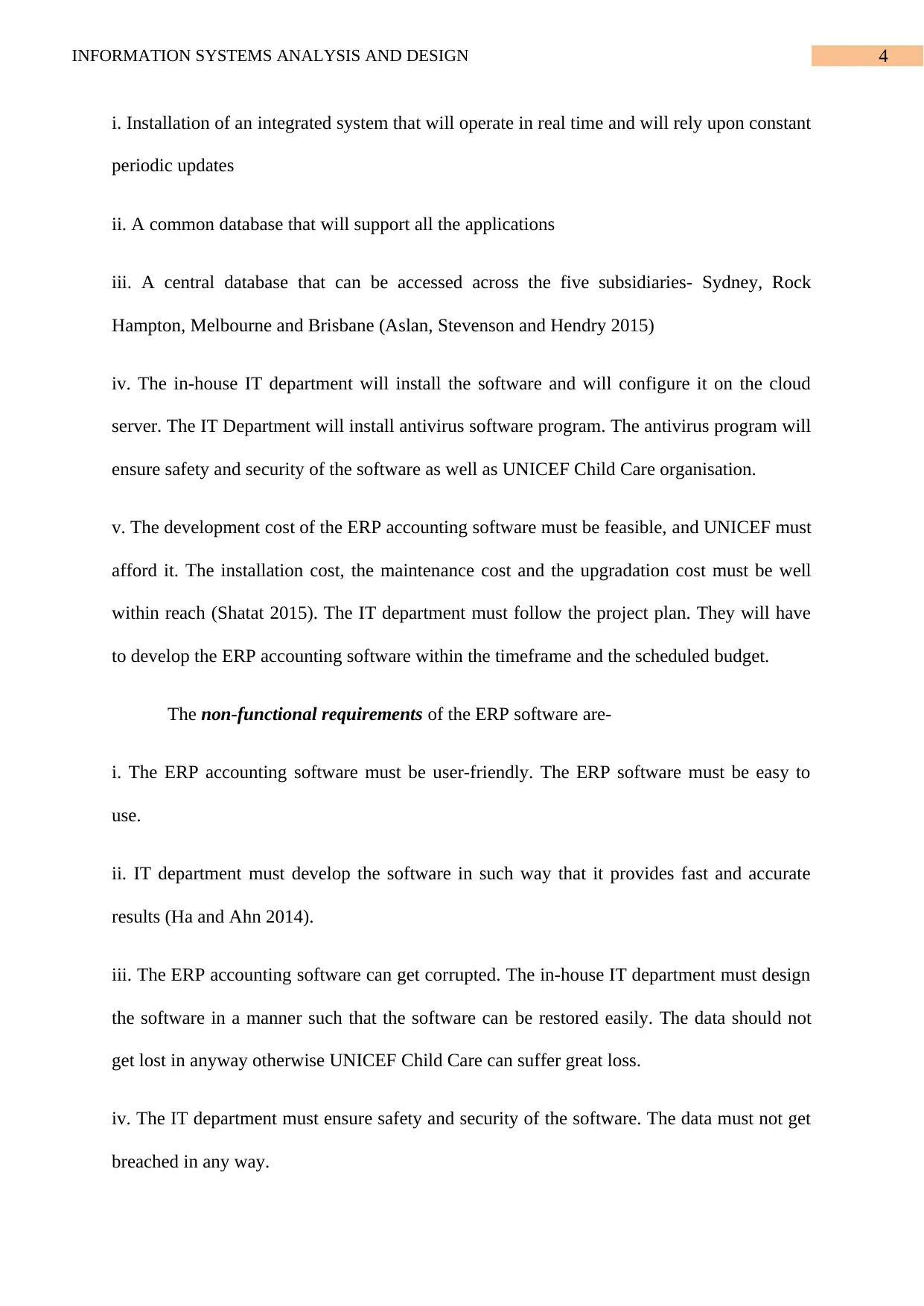
4INFORMATION SYSTEMS ANALYSIS AND DESIGN
i. Installation of an integrated system that will operate in real time and will rely upon constant
periodic updates
ii. A common database that will support all the applications
iii. A central database that can be accessed across the five subsidiaries- Sydney, Rock
Hampton, Melbourne and Brisbane (Aslan, Stevenson and Hendry 2015)
iv. The in-house IT department will install the software and will configure it on the cloud
server. The IT Department will install antivirus software program. The antivirus program will
ensure safety and security of the software as well as UNICEF Child Care organisation.
v. The development cost of the ERP accounting software must be feasible, and UNICEF must
afford it. The installation cost, the maintenance cost and the upgradation cost must be well
within reach (Shatat 2015). The IT department must follow the project plan. They will have
to develop the ERP accounting software within the timeframe and the scheduled budget.
The non-functional requirements of the ERP software are-
i. The ERP accounting software must be user-friendly. The ERP software must be easy to
use.
ii. IT department must develop the software in such way that it provides fast and accurate
results (Ha and Ahn 2014).
iii. The ERP accounting software can get corrupted. The in-house IT department must design
the software in a manner such that the software can be restored easily. The data should not
get lost in anyway otherwise UNICEF Child Care can suffer great loss.
iv. The IT department must ensure safety and security of the software. The data must not get
breached in any way.
i. Installation of an integrated system that will operate in real time and will rely upon constant
periodic updates
ii. A common database that will support all the applications
iii. A central database that can be accessed across the five subsidiaries- Sydney, Rock
Hampton, Melbourne and Brisbane (Aslan, Stevenson and Hendry 2015)
iv. The in-house IT department will install the software and will configure it on the cloud
server. The IT Department will install antivirus software program. The antivirus program will
ensure safety and security of the software as well as UNICEF Child Care organisation.
v. The development cost of the ERP accounting software must be feasible, and UNICEF must
afford it. The installation cost, the maintenance cost and the upgradation cost must be well
within reach (Shatat 2015). The IT department must follow the project plan. They will have
to develop the ERP accounting software within the timeframe and the scheduled budget.
The non-functional requirements of the ERP software are-
i. The ERP accounting software must be user-friendly. The ERP software must be easy to
use.
ii. IT department must develop the software in such way that it provides fast and accurate
results (Ha and Ahn 2014).
iii. The ERP accounting software can get corrupted. The in-house IT department must design
the software in a manner such that the software can be restored easily. The data should not
get lost in anyway otherwise UNICEF Child Care can suffer great loss.
iv. The IT department must ensure safety and security of the software. The data must not get
breached in any way.
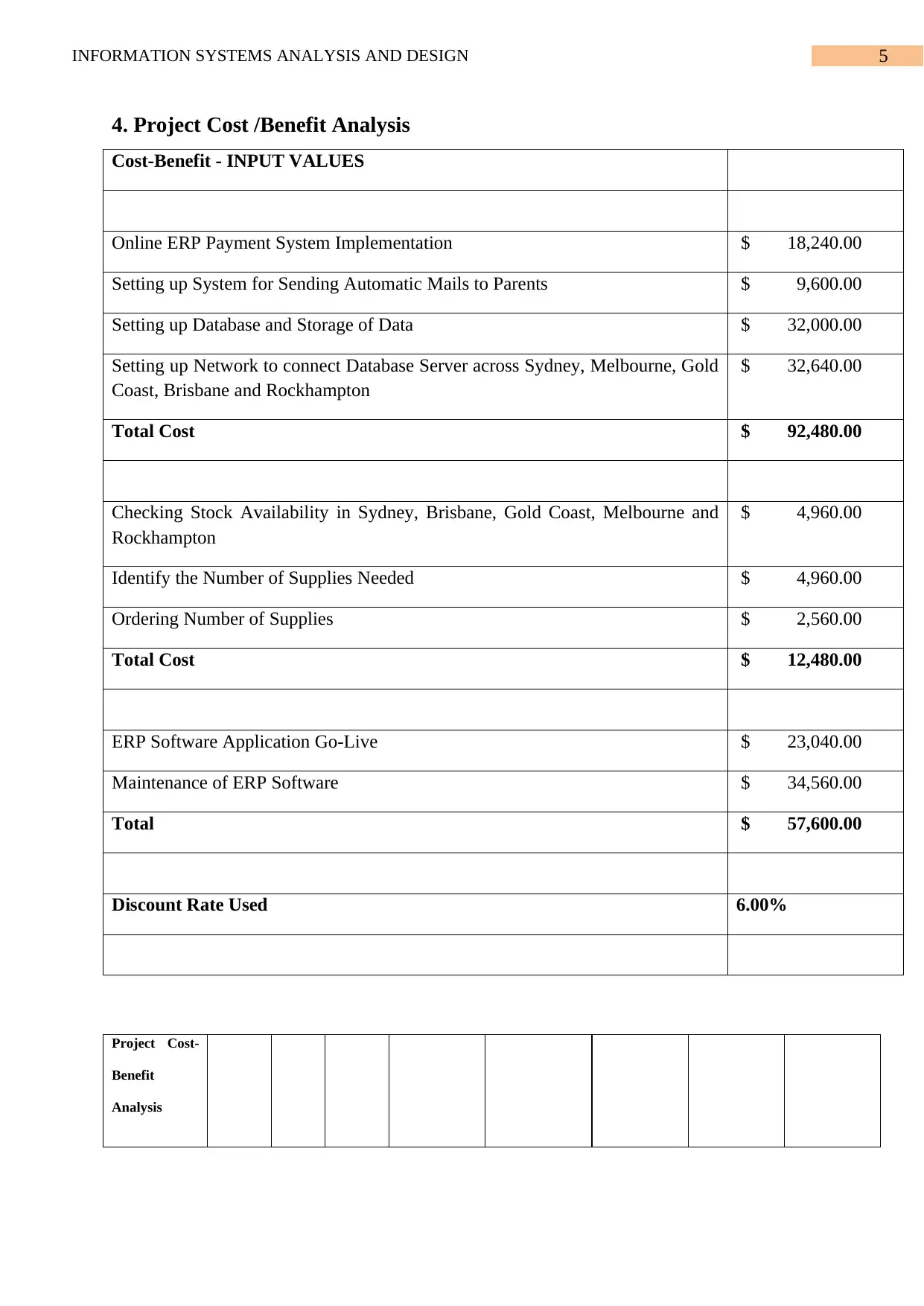
5INFORMATION SYSTEMS ANALYSIS AND DESIGN
4. Project Cost /Benefit Analysis
Cost-Benefit - INPUT VALUES
Online ERP Payment System Implementation $ 18,240.00
Setting up System for Sending Automatic Mails to Parents $ 9,600.00
Setting up Database and Storage of Data $ 32,000.00
Setting up Network to connect Database Server across Sydney, Melbourne, Gold
Coast, Brisbane and Rockhampton
$ 32,640.00
Total Cost $ 92,480.00
Checking Stock Availability in Sydney, Brisbane, Gold Coast, Melbourne and
Rockhampton
$ 4,960.00
Identify the Number of Supplies Needed $ 4,960.00
Ordering Number of Supplies $ 2,560.00
Total Cost $ 12,480.00
ERP Software Application Go-Live $ 23,040.00
Maintenance of ERP Software $ 34,560.00
Total $ 57,600.00
Discount Rate Used 6.00%
Project Cost-
Benefit
Analysis
4. Project Cost /Benefit Analysis
Cost-Benefit - INPUT VALUES
Online ERP Payment System Implementation $ 18,240.00
Setting up System for Sending Automatic Mails to Parents $ 9,600.00
Setting up Database and Storage of Data $ 32,000.00
Setting up Network to connect Database Server across Sydney, Melbourne, Gold
Coast, Brisbane and Rockhampton
$ 32,640.00
Total Cost $ 92,480.00
Checking Stock Availability in Sydney, Brisbane, Gold Coast, Melbourne and
Rockhampton
$ 4,960.00
Identify the Number of Supplies Needed $ 4,960.00
Ordering Number of Supplies $ 2,560.00
Total Cost $ 12,480.00
ERP Software Application Go-Live $ 23,040.00
Maintenance of ERP Software $ 34,560.00
Total $ 57,600.00
Discount Rate Used 6.00%
Project Cost-
Benefit
Analysis
⊘ This is a preview!⊘
Do you want full access?
Subscribe today to unlock all pages.

Trusted by 1+ million students worldwide
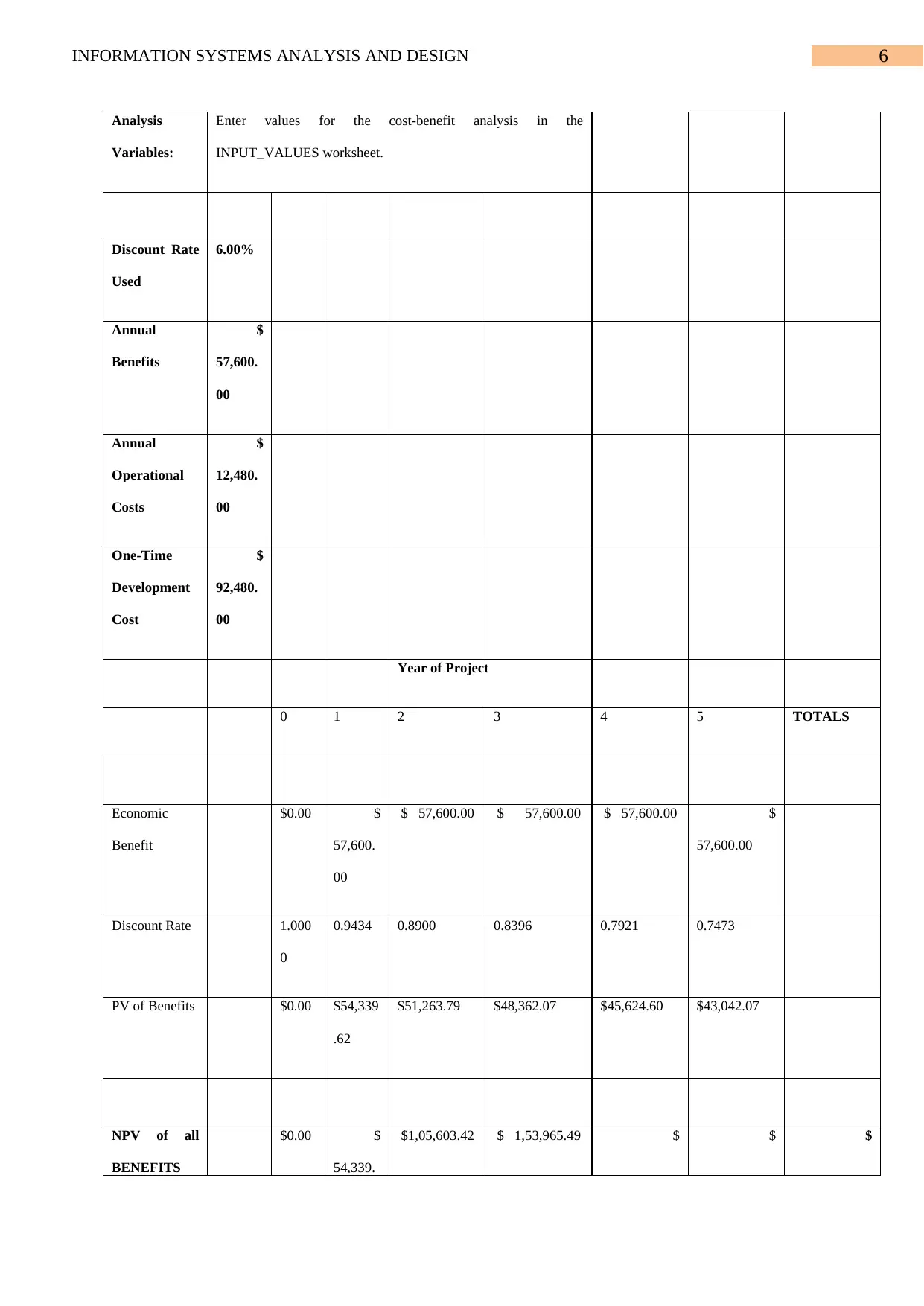
6INFORMATION SYSTEMS ANALYSIS AND DESIGN
Analysis
Variables:
Enter values for the cost-benefit analysis in the
INPUT_VALUES worksheet.
Discount Rate
Used
6.00%
Annual
Benefits
$
57,600.
00
Annual
Operational
Costs
$
12,480.
00
One-Time
Development
Cost
$
92,480.
00
Year of Project
0 1 2 3 4 5 TOTALS
Economic
Benefit
$0.00 $
57,600.
00
$ 57,600.00 $ 57,600.00 $ 57,600.00 $
57,600.00
Discount Rate 1.000
0
0.9434 0.8900 0.8396 0.7921 0.7473
PV of Benefits $0.00 $54,339
.62
$51,263.79 $48,362.07 $45,624.60 $43,042.07
NPV of all
BENEFITS
$0.00 $
54,339.
$1,05,603.42 $ 1,53,965.49 $ $ $
Analysis
Variables:
Enter values for the cost-benefit analysis in the
INPUT_VALUES worksheet.
Discount Rate
Used
6.00%
Annual
Benefits
$
57,600.
00
Annual
Operational
Costs
$
12,480.
00
One-Time
Development
Cost
$
92,480.
00
Year of Project
0 1 2 3 4 5 TOTALS
Economic
Benefit
$0.00 $
57,600.
00
$ 57,600.00 $ 57,600.00 $ 57,600.00 $
57,600.00
Discount Rate 1.000
0
0.9434 0.8900 0.8396 0.7921 0.7473
PV of Benefits $0.00 $54,339
.62
$51,263.79 $48,362.07 $45,624.60 $43,042.07
NPV of all
BENEFITS
$0.00 $
54,339.
$1,05,603.42 $ 1,53,965.49 $ $ $
Paraphrase This Document
Need a fresh take? Get an instant paraphrase of this document with our AI Paraphraser
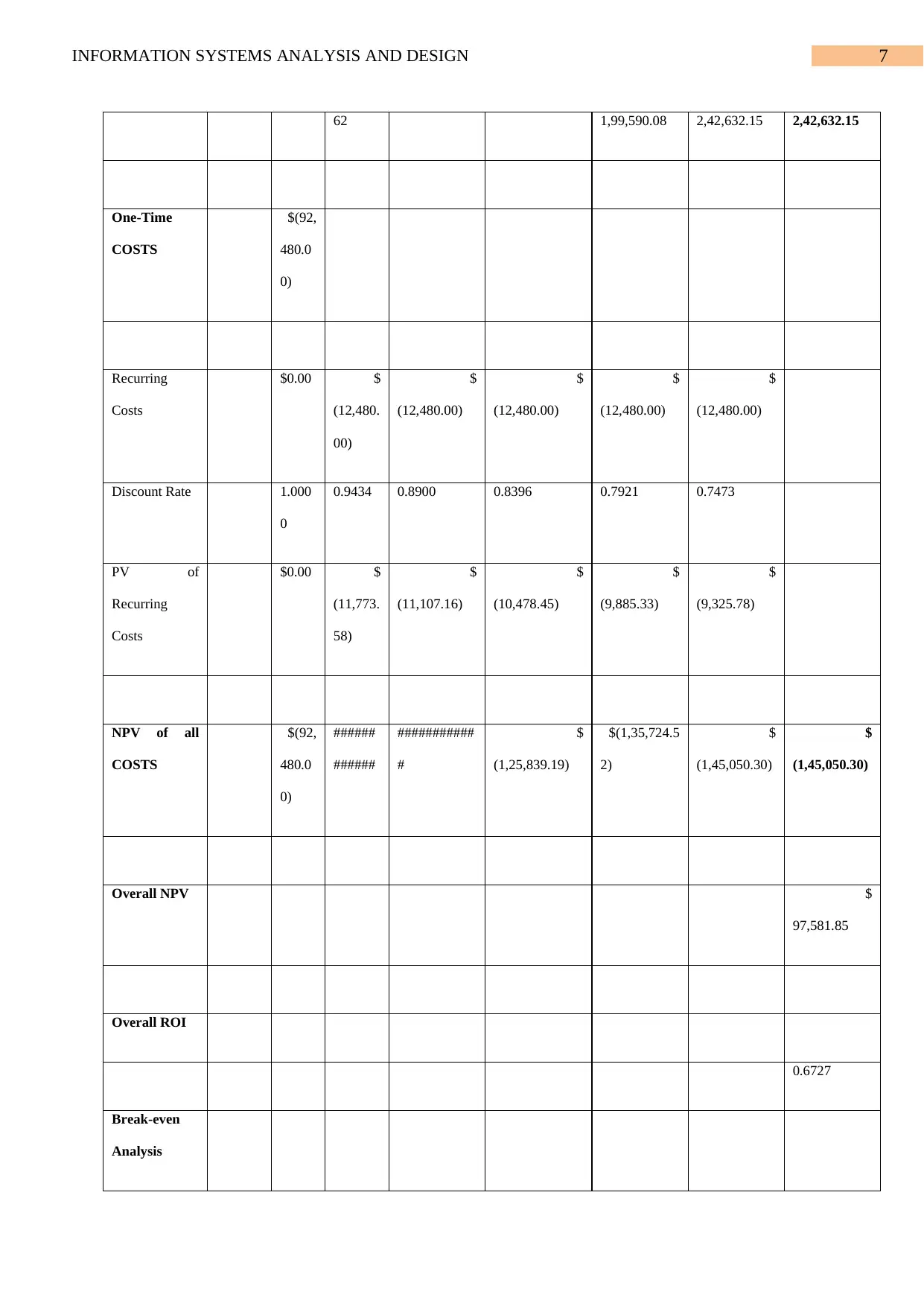
7INFORMATION SYSTEMS ANALYSIS AND DESIGN
62 1,99,590.08 2,42,632.15 2,42,632.15
One-Time
COSTS
$(92,
480.0
0)
Recurring
Costs
$0.00 $
(12,480.
00)
$
(12,480.00)
$
(12,480.00)
$
(12,480.00)
$
(12,480.00)
Discount Rate 1.000
0
0.9434 0.8900 0.8396 0.7921 0.7473
PV of
Recurring
Costs
$0.00 $
(11,773.
58)
$
(11,107.16)
$
(10,478.45)
$
(9,885.33)
$
(9,325.78)
NPV of all
COSTS
$(92,
480.0
0)
######
######
###########
#
$
(1,25,839.19)
$(1,35,724.5
2)
$
(1,45,050.30)
$
(1,45,050.30)
Overall NPV $
97,581.85
Overall ROI
0.6727
Break-even
Analysis
62 1,99,590.08 2,42,632.15 2,42,632.15
One-Time
COSTS
$(92,
480.0
0)
Recurring
Costs
$0.00 $
(12,480.
00)
$
(12,480.00)
$
(12,480.00)
$
(12,480.00)
$
(12,480.00)
Discount Rate 1.000
0
0.9434 0.8900 0.8396 0.7921 0.7473
PV of
Recurring
Costs
$0.00 $
(11,773.
58)
$
(11,107.16)
$
(10,478.45)
$
(9,885.33)
$
(9,325.78)
NPV of all
COSTS
$(92,
480.0
0)
######
######
###########
#
$
(1,25,839.19)
$(1,35,724.5
2)
$
(1,45,050.30)
$
(1,45,050.30)
Overall NPV $
97,581.85
Overall ROI
0.6727
Break-even
Analysis
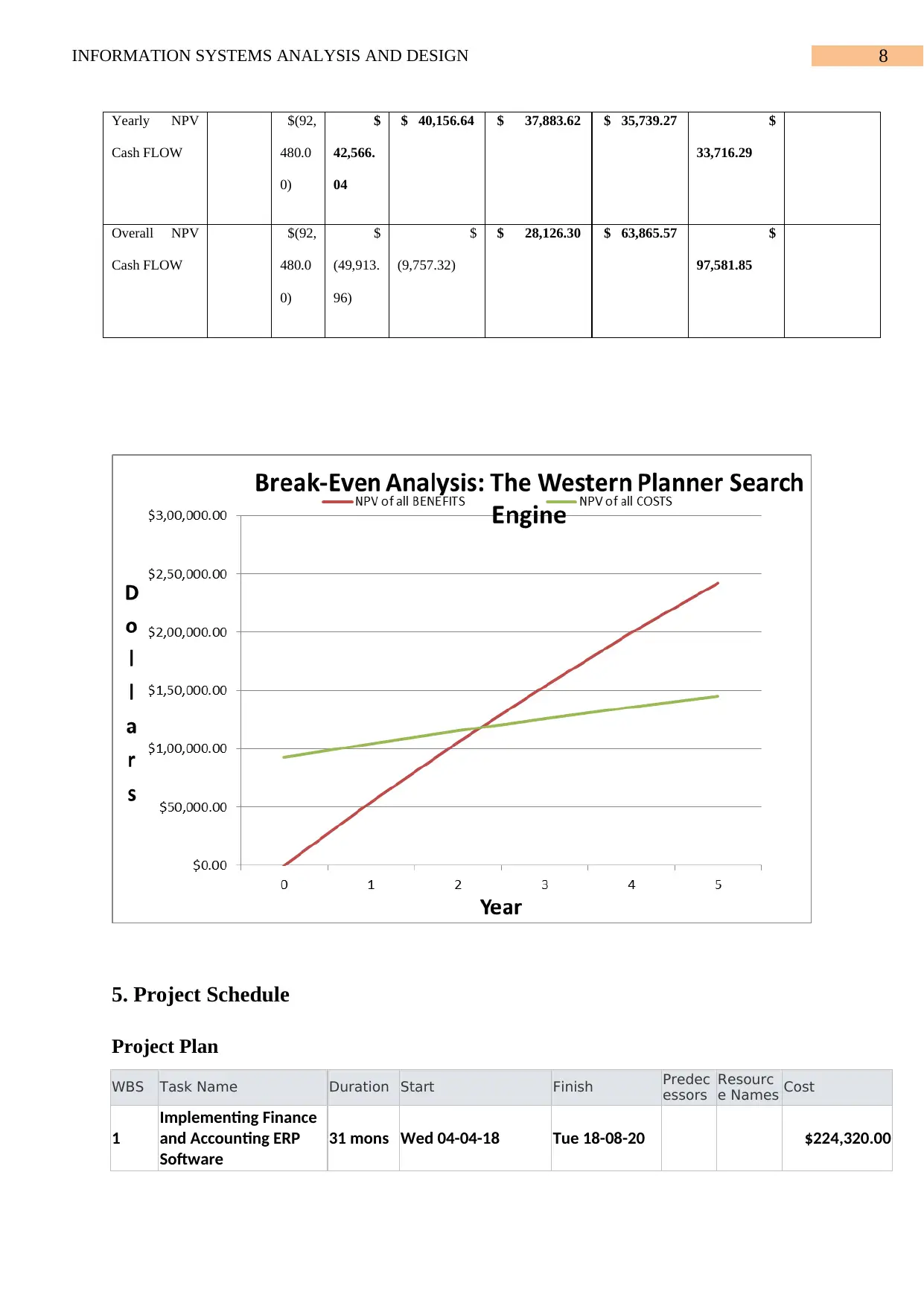
8INFORMATION SYSTEMS ANALYSIS AND DESIGN
Yearly NPV
Cash FLOW
$(92,
480.0
0)
$
42,566.
04
$ 40,156.64 $ 37,883.62 $ 35,739.27 $
33,716.29
Overall NPV
Cash FLOW
$(92,
480.0
0)
$
(49,913.
96)
$
(9,757.32)
$ 28,126.30 $ 63,865.57 $
97,581.85
5. Project Schedule
Project Plan
WBS Task Name Duration Start Finish Predec
essors
Resourc
e Names Cost
1
Implementing Finance
and Accounting ERP
Software
31 mons Wed 04-04-18 Tue 18-08-20 $224,320.00
Yearly NPV
Cash FLOW
$(92,
480.0
0)
$
42,566.
04
$ 40,156.64 $ 37,883.62 $ 35,739.27 $
33,716.29
Overall NPV
Cash FLOW
$(92,
480.0
0)
$
(49,913.
96)
$
(9,757.32)
$ 28,126.30 $ 63,865.57 $
97,581.85
5. Project Schedule
Project Plan
WBS Task Name Duration Start Finish Predec
essors
Resourc
e Names Cost
1
Implementing Finance
and Accounting ERP
Software
31 mons Wed 04-04-18 Tue 18-08-20 $224,320.00
⊘ This is a preview!⊘
Do you want full access?
Subscribe today to unlock all pages.

Trusted by 1+ million students worldwide
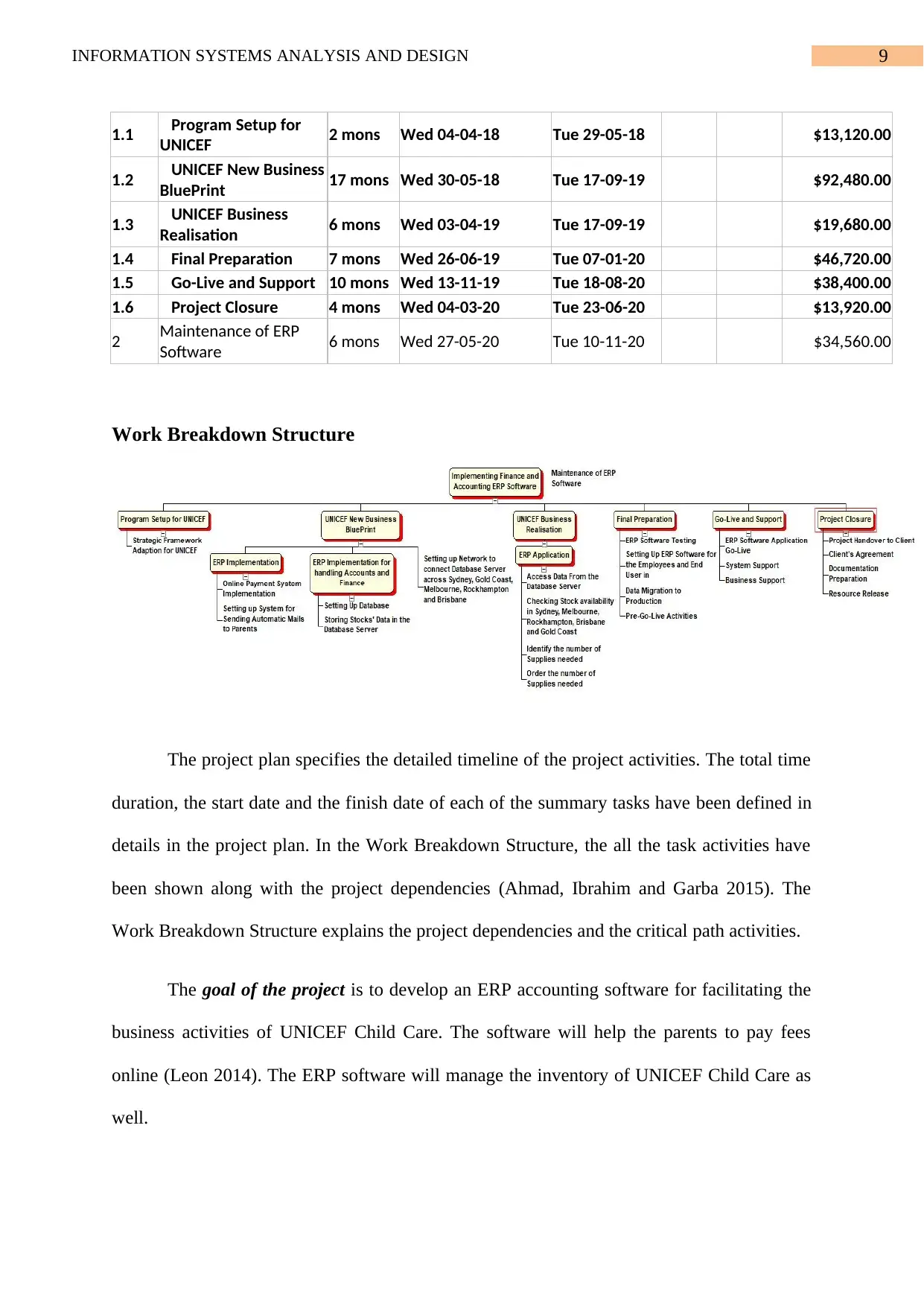
9INFORMATION SYSTEMS ANALYSIS AND DESIGN
1.1 Program Setup for
UNICEF 2 mons Wed 04-04-18 Tue 29-05-18 $13,120.00
1.2 UNICEF New Business
BluePrint 17 mons Wed 30-05-18 Tue 17-09-19 $92,480.00
1.3 UNICEF Business
Realisation 6 mons Wed 03-04-19 Tue 17-09-19 $19,680.00
1.4 Final Preparation 7 mons Wed 26-06-19 Tue 07-01-20 $46,720.00
1.5 Go-Live and Support 10 mons Wed 13-11-19 Tue 18-08-20 $38,400.00
1.6 Project Closure 4 mons Wed 04-03-20 Tue 23-06-20 $13,920.00
2 Maintenance of ERP
Software 6 mons Wed 27-05-20 Tue 10-11-20 $34,560.00
Work Breakdown Structure
The project plan specifies the detailed timeline of the project activities. The total time
duration, the start date and the finish date of each of the summary tasks have been defined in
details in the project plan. In the Work Breakdown Structure, the all the task activities have
been shown along with the project dependencies (Ahmad, Ibrahim and Garba 2015). The
Work Breakdown Structure explains the project dependencies and the critical path activities.
The goal of the project is to develop an ERP accounting software for facilitating the
business activities of UNICEF Child Care. The software will help the parents to pay fees
online (Leon 2014). The ERP software will manage the inventory of UNICEF Child Care as
well.
1.1 Program Setup for
UNICEF 2 mons Wed 04-04-18 Tue 29-05-18 $13,120.00
1.2 UNICEF New Business
BluePrint 17 mons Wed 30-05-18 Tue 17-09-19 $92,480.00
1.3 UNICEF Business
Realisation 6 mons Wed 03-04-19 Tue 17-09-19 $19,680.00
1.4 Final Preparation 7 mons Wed 26-06-19 Tue 07-01-20 $46,720.00
1.5 Go-Live and Support 10 mons Wed 13-11-19 Tue 18-08-20 $38,400.00
1.6 Project Closure 4 mons Wed 04-03-20 Tue 23-06-20 $13,920.00
2 Maintenance of ERP
Software 6 mons Wed 27-05-20 Tue 10-11-20 $34,560.00
Work Breakdown Structure
The project plan specifies the detailed timeline of the project activities. The total time
duration, the start date and the finish date of each of the summary tasks have been defined in
details in the project plan. In the Work Breakdown Structure, the all the task activities have
been shown along with the project dependencies (Ahmad, Ibrahim and Garba 2015). The
Work Breakdown Structure explains the project dependencies and the critical path activities.
The goal of the project is to develop an ERP accounting software for facilitating the
business activities of UNICEF Child Care. The software will help the parents to pay fees
online (Leon 2014). The ERP software will manage the inventory of UNICEF Child Care as
well.
Paraphrase This Document
Need a fresh take? Get an instant paraphrase of this document with our AI Paraphraser
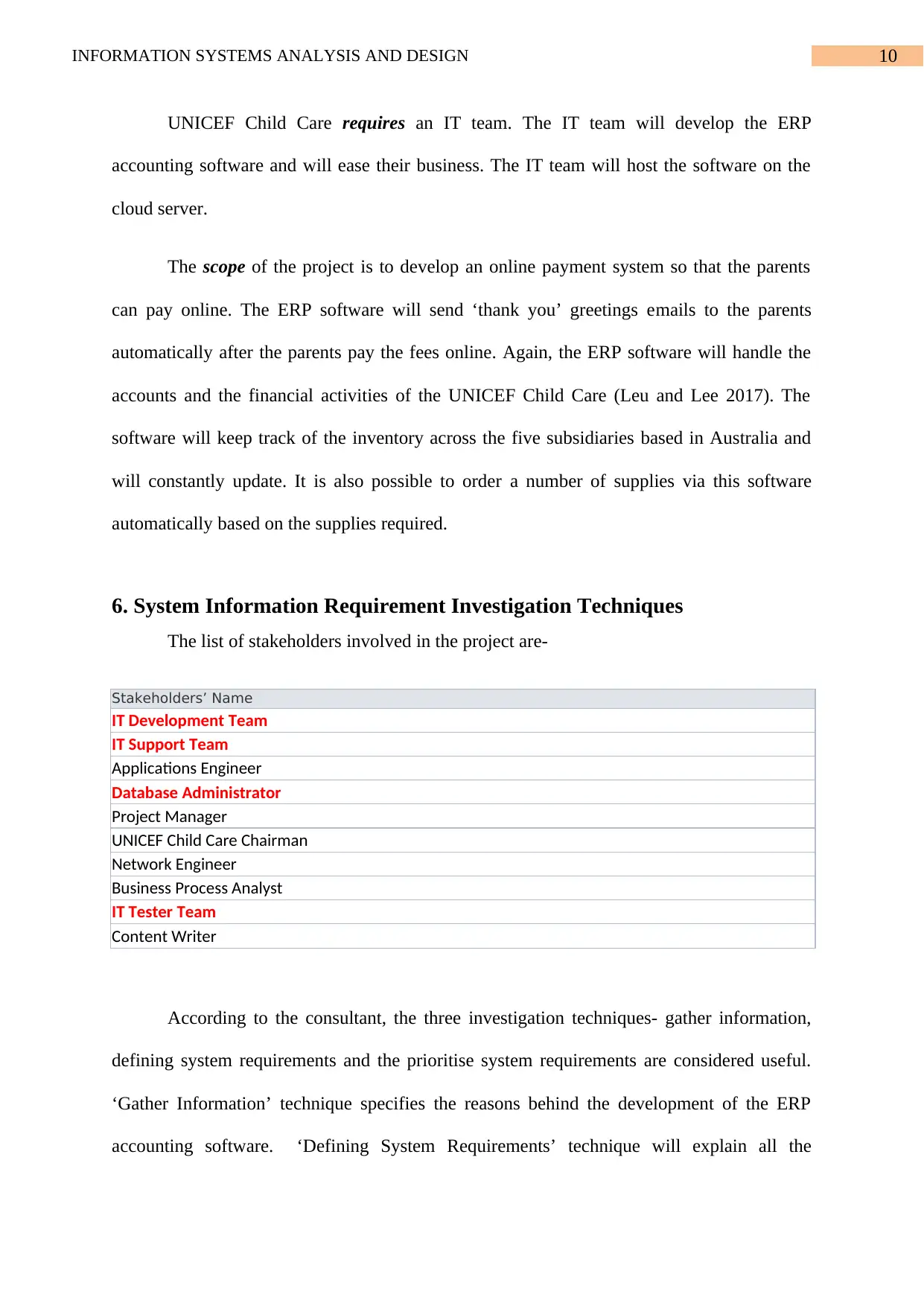
10INFORMATION SYSTEMS ANALYSIS AND DESIGN
UNICEF Child Care requires an IT team. The IT team will develop the ERP
accounting software and will ease their business. The IT team will host the software on the
cloud server.
The scope of the project is to develop an online payment system so that the parents
can pay online. The ERP software will send ‘thank you’ greetings emails to the parents
automatically after the parents pay the fees online. Again, the ERP software will handle the
accounts and the financial activities of the UNICEF Child Care (Leu and Lee 2017). The
software will keep track of the inventory across the five subsidiaries based in Australia and
will constantly update. It is also possible to order a number of supplies via this software
automatically based on the supplies required.
6. System Information Requirement Investigation Techniques
The list of stakeholders involved in the project are-
Stakeholders’ Name
IT Development Team
IT Support Team
Applications Engineer
Database Administrator
Project Manager
UNICEF Child Care Chairman
Network Engineer
Business Process Analyst
IT Tester Team
Content Writer
According to the consultant, the three investigation techniques- gather information,
defining system requirements and the prioritise system requirements are considered useful.
‘Gather Information’ technique specifies the reasons behind the development of the ERP
accounting software. ‘Defining System Requirements’ technique will explain all the
UNICEF Child Care requires an IT team. The IT team will develop the ERP
accounting software and will ease their business. The IT team will host the software on the
cloud server.
The scope of the project is to develop an online payment system so that the parents
can pay online. The ERP software will send ‘thank you’ greetings emails to the parents
automatically after the parents pay the fees online. Again, the ERP software will handle the
accounts and the financial activities of the UNICEF Child Care (Leu and Lee 2017). The
software will keep track of the inventory across the five subsidiaries based in Australia and
will constantly update. It is also possible to order a number of supplies via this software
automatically based on the supplies required.
6. System Information Requirement Investigation Techniques
The list of stakeholders involved in the project are-
Stakeholders’ Name
IT Development Team
IT Support Team
Applications Engineer
Database Administrator
Project Manager
UNICEF Child Care Chairman
Network Engineer
Business Process Analyst
IT Tester Team
Content Writer
According to the consultant, the three investigation techniques- gather information,
defining system requirements and the prioritise system requirements are considered useful.
‘Gather Information’ technique specifies the reasons behind the development of the ERP
accounting software. ‘Defining System Requirements’ technique will explain all the
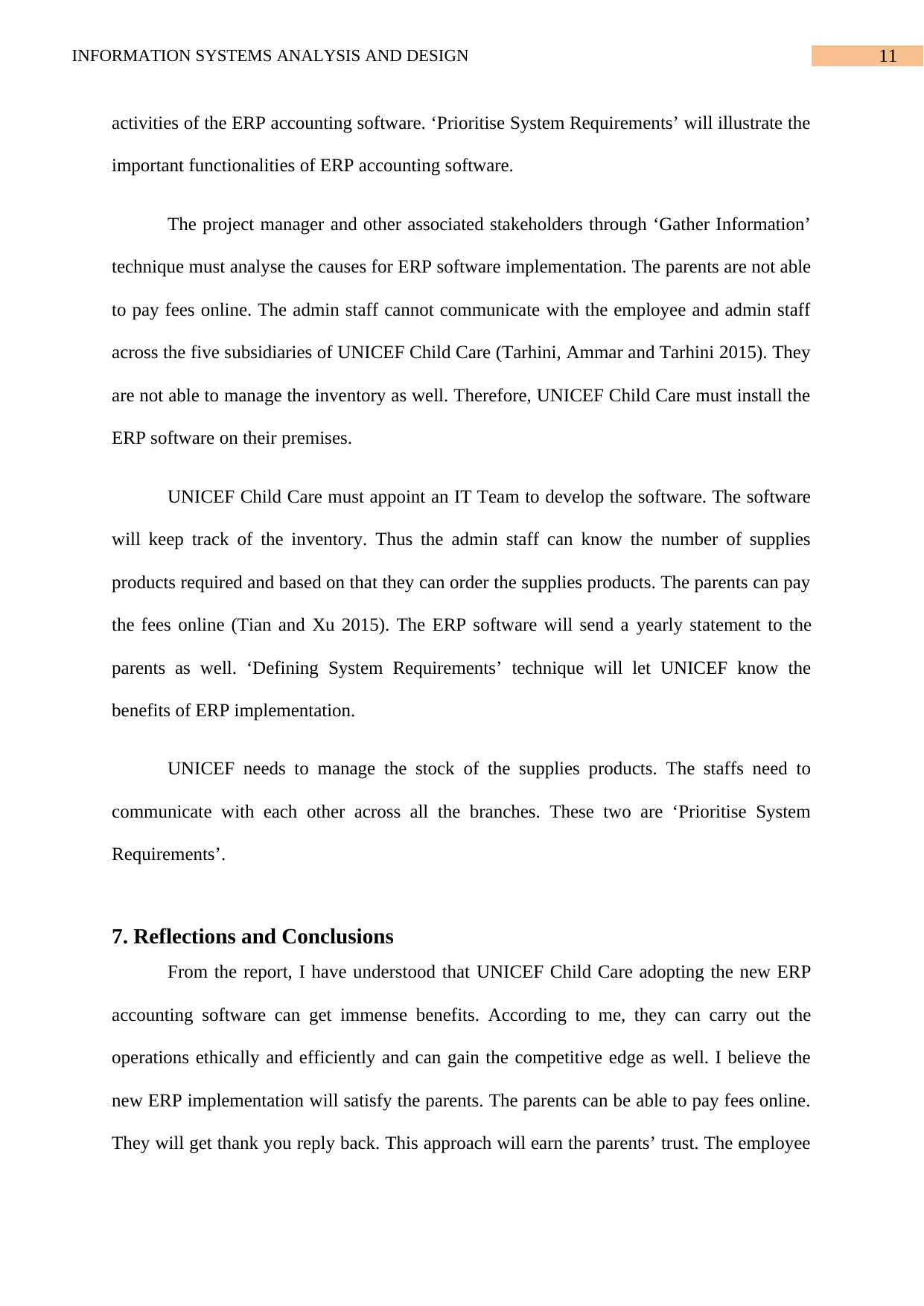
11INFORMATION SYSTEMS ANALYSIS AND DESIGN
activities of the ERP accounting software. ‘Prioritise System Requirements’ will illustrate the
important functionalities of ERP accounting software.
The project manager and other associated stakeholders through ‘Gather Information’
technique must analyse the causes for ERP software implementation. The parents are not able
to pay fees online. The admin staff cannot communicate with the employee and admin staff
across the five subsidiaries of UNICEF Child Care (Tarhini, Ammar and Tarhini 2015). They
are not able to manage the inventory as well. Therefore, UNICEF Child Care must install the
ERP software on their premises.
UNICEF Child Care must appoint an IT Team to develop the software. The software
will keep track of the inventory. Thus the admin staff can know the number of supplies
products required and based on that they can order the supplies products. The parents can pay
the fees online (Tian and Xu 2015). The ERP software will send a yearly statement to the
parents as well. ‘Defining System Requirements’ technique will let UNICEF know the
benefits of ERP implementation.
UNICEF needs to manage the stock of the supplies products. The staffs need to
communicate with each other across all the branches. These two are ‘Prioritise System
Requirements’.
7. Reflections and Conclusions
From the report, I have understood that UNICEF Child Care adopting the new ERP
accounting software can get immense benefits. According to me, they can carry out the
operations ethically and efficiently and can gain the competitive edge as well. I believe the
new ERP implementation will satisfy the parents. The parents can be able to pay fees online.
They will get thank you reply back. This approach will earn the parents’ trust. The employee
activities of the ERP accounting software. ‘Prioritise System Requirements’ will illustrate the
important functionalities of ERP accounting software.
The project manager and other associated stakeholders through ‘Gather Information’
technique must analyse the causes for ERP software implementation. The parents are not able
to pay fees online. The admin staff cannot communicate with the employee and admin staff
across the five subsidiaries of UNICEF Child Care (Tarhini, Ammar and Tarhini 2015). They
are not able to manage the inventory as well. Therefore, UNICEF Child Care must install the
ERP software on their premises.
UNICEF Child Care must appoint an IT Team to develop the software. The software
will keep track of the inventory. Thus the admin staff can know the number of supplies
products required and based on that they can order the supplies products. The parents can pay
the fees online (Tian and Xu 2015). The ERP software will send a yearly statement to the
parents as well. ‘Defining System Requirements’ technique will let UNICEF know the
benefits of ERP implementation.
UNICEF needs to manage the stock of the supplies products. The staffs need to
communicate with each other across all the branches. These two are ‘Prioritise System
Requirements’.
7. Reflections and Conclusions
From the report, I have understood that UNICEF Child Care adopting the new ERP
accounting software can get immense benefits. According to me, they can carry out the
operations ethically and efficiently and can gain the competitive edge as well. I believe the
new ERP implementation will satisfy the parents. The parents can be able to pay fees online.
They will get thank you reply back. This approach will earn the parents’ trust. The employee
⊘ This is a preview!⊘
Do you want full access?
Subscribe today to unlock all pages.

Trusted by 1+ million students worldwide
1 out of 14
Related Documents
Your All-in-One AI-Powered Toolkit for Academic Success.
+13062052269
info@desklib.com
Available 24*7 on WhatsApp / Email
![[object Object]](/_next/static/media/star-bottom.7253800d.svg)
Unlock your academic potential
Copyright © 2020–2025 A2Z Services. All Rights Reserved. Developed and managed by ZUCOL.



